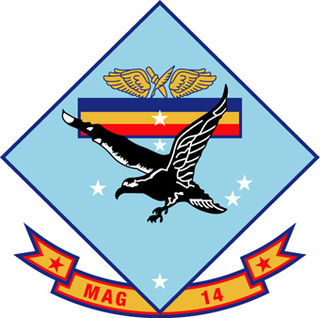
Marine Aircraft Group 14 (MAG-14) is a United States Marine Corps aviation unit based at Marine Corps Air Station Cherry Point, North Carolina that is currently composed of four AV-8B Harrier squadrons, one F-35C squadron, one UAV squadron, one KC-130 squadron, and an aviation logistics squadron.
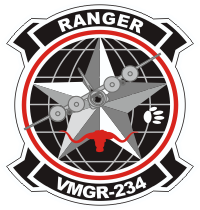
Marine Aerial Refueler Transport Squadron 234 (VMGR-234) is a reserve United States Marine Corps KC-130J squadron. They are a part of Marine Aircraft Group 41 (MAG-41), 4th Marine Aircraft Wing and provide both fixed-wing and rotary-wing aerial refueling capabilities to support Marine Forces Reserve air operations in addition to assault air transport of personnel, equipment, and supplies. The squadron, known as the "Rangers" is stationed at Naval Air Station Joint Reserve Base Fort Worth, Texas.

Marine Aircraft Group 32 (MAG-32) was a United States Marine Corps aviation unit established during World War II.
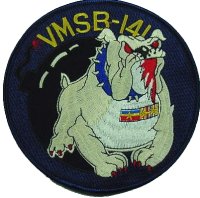
Marine Attack Squadron 141 (VMA-141) was a reserve fighter squadron in the United States Marine Corps. The squadron fought most notably as part of the Cactus Air Force during the Battle of Guadalcanal in World War II and they also saw service during the Korean War. While with the reserves, they operated out of the San Francisco Bay Area, until their deactivation on 1 September 1969.
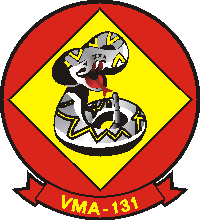
Marine Attack Squadron 131 (VMA-131) was an A-4 Skyhawk attack squadron in the United States Marine Corps. The squadron, also known as the “Diamondbacks”, were part of the Marine Forces Reserve and were based at Naval Air Station New York, Brooklyn, New York from 1960 through 1970 and NASJRB Willow Grove from 1971 until their deactivation in 1998.

Marine Attack Squadron 331 (VMA-331) was an attack squadron in the United States Marine Corps. The squadron, also known as the “Doodlebugs” and “Bumblebees,” was part of Marine Aircraft Group 31, 2nd Marine Aircraft Wing and was based out of Marine Corps Air Station Beaufort, South Carolina. The squadron fought in World War II and Operation Desert Storm. It was decommissioned as part of the post Cold War drawdown of the US Military on October 1, 1992.

Marine Attack Squadron 133 (VMA-133) was a reserve A-4 Skyhawk fighter squadron in the United States Marine Corps. Originally known as VMSB-133, the squadron saw combat during the World War II campaigns on Bougainville and Philippines. Following the war they became part of the Marine Forces Reserve. The squadron, also known as the “Dragons”, was part of Marine Aircraft Group 42 of the 4th Marine Aircraft Wing and was based out of Naval Air Station Alameda, California. They were deactivated in 1992 as part of the post Cold War drawdown of the U.S. Military.
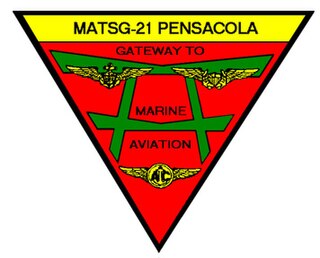
Marine Aviation and Training Support Group 21 (MATSG-21) is a United States Marine Corps aviation training group that was originally established in 1922 as the 2nd Aviation Group. During World War II the unit was known as Marine Aircraft Group 21 (MAG-21). Squadrons from MAG-21 fought in many of the opening battles of the war to include the Battle of Wake Island, Battle of Midway and as part of the Cactus Air Force during the Battle of Guadalcanal The group was deactivated following the end of the war and was not reactivated until 2000 when the Marine Aviation Detachment at Naval Air Station Pensacola, Florida was renamed MATSG-21. The core of the MATSG personnel is derived from 175 officer instructors and 550 student naval aviators/naval flight officers.

Marine Fighting Squadron 132 (VMF-132) was a fighter squadron in the United States Marine Corps. The squadron, also known as “The Crying Red Asses”, fought in World War II as a dive bomber unit during the Battle of Guadalcanal as part of the Cactus Air Force and later fought in the Central Solomon Islands. They were deactivated shortly after the end of the war but were reactivated in the Marine Air Reserve flying out of Floyd Bennett Field in Brooklyn, New York. They were again deactivated sometime after 1958.

Marine Torpedo Bombing Squadron 151 (VMTB-151) was a dive bombing squadron in the United States Marine Corps. The squadron fought in World War II but was quickly deactivated after the war on March 20, 1946.

Marine Scout Bombing Squadron 243 (VMSB-243) was a dive bomber squadron in the United States Marine Corps. The squadron, also known as the “Flying Goldbricks”, fought in World War II during the Battle of Bougainville and later in the Philippines campaign (1944–45). They were deactivated shortly after the end of the war on September 25, 1945.

Marine Scout Bombing Squadron 245 (VMSB-245) was a dive bomber squadron in the United States Marine Corps. The squadron, also known as the “Red Mousie Squadron”, fought in World War II. They were deactivated on November 17, 1945, shortly after the end of the war.
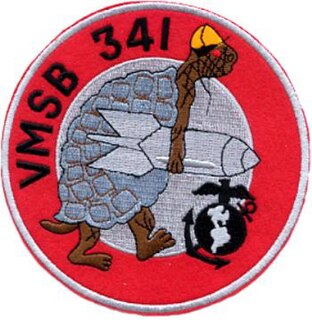
Marine Scout-Bomber Squadron 341 (VMSB-341) was a dive bomber squadron in the United States Marine Corps. The squadron, also known as the “Torrid Turtles”, fought in World War II with Marine Aircraft Group 24, most notably in the Philippines campaign (1944–45). They were deactivated shortly after the end of the war on September 13, 1945.
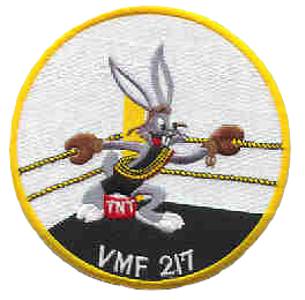
Marine Attack Squadron 217 (VMA-217) was a fighter squadron of the United States Marine Corps that was activated and fought during World War II. Known as “Max’s Wild Hares”, they fought in many areas of the Pacific War including the Battle of Iwo Jima. Following the surrender of Japan, the squadron was deactivated on March 10, 1946. They were briefly reactivated as part of the Reserves but were again deactivated in 1964 and remain in an inactive status today.

Marine Fighting Squadron 215 (VMF-215) was a fighter squadron of the United States Marine Corps that was commissioned and fought during World War II. Known as "The Fighting Corsairs", the squadron fought in many areas of the Pacific War, including the Battle of Bougainville. During its four-and-a-half month tour, the squadron was credited with shooting down 137 enemy aircraft, fourth most in Marine Corps aviation history.

Marine Attack Squadron 233 (VMA-233) was an A-4 Skyhawk attack squadron in the United States Marine Corps. The squadron, also known as the “Flying Deadheads”, were part of the Marine Forces Reserve and were based at Naval Air Station Norfolk, Virginia until their decommissioning in 1969. Originally activated during World War II, they fought in many areas of the Pacific War including the Battle of Guadalcanal as part of the Cactus Air Force, the Battle of Okinawa and the Battle of Balikpapan (1945). They were the only Marine Corps squadron to have three commanding officers killed during the course of the war and were credited with downing 8 Japanese aircraft. Following the surrender of Japan, the squadron was decommissioned on March 10, 1946. They were reactivated as part of the Reserves but were again decommissioned in 1969.

Marine Fighting Squadron 236 (VMF-236) was a fighter squadron in the United States Marine Corps. The squadron, also known as the “Black Panthers”, was part of the Marine Forces Reserve for a short time following World War II and were based at Naval Air Station Denver, Colorado until their disestablishment. Originally established during World War II, they fought in the Pacific War most notably during the Bougainville Campaign and the campaign to liberate the Philippines. The squadron conducted the first dive bombing attack against Bougainville and was credited with downing 4 Japanese aircraft during the course of the war. VMSB-236 was disestablished on August 1, 1945 at Mindanao, Philippines two weeks before the surrender of Japan They were reactivated as part of the Reserves but were again deactivated in the late 1960s and remain in an inactive status today.
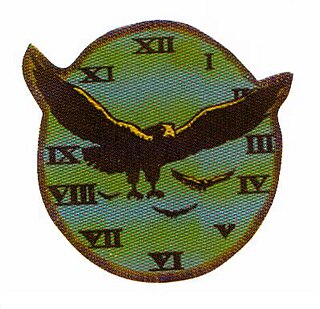
Marine Attack Squadron 543 (VMA-543) was an aviation unit of the United States Marine Corps. The squadron, also known as the “Night Hawks”, were part of the Marine Forces Reserve and were based at Naval Air Station Glenview, Illinois until their deactivation on April 1, 1974. Originally activated during World War II, they fought in the Battle of Okinawa as part of the Tactical Air Force. The squadron was credited with downing 15 Japanese aircraft during the war. Following the surrender of Japan, the squadron was deactivated only to be later reactivated as part of the Reserves. They were again deactivated in 1974 and remain in an inactive status today.
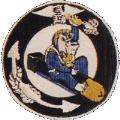
Marine Attack Squadron 143 (VMA-143), nicknamed the Rocket Raiders, was a reserve attack squadron in the United States Marine Corps. Originally commissioned during World War II, the squadron fought at the Guadalcanal, New Georgia, the Battle of Bougainville, Battle of Okinawa, and the Battle of Balikpapan.
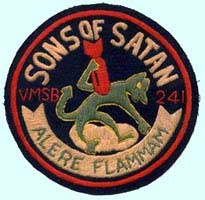
Marine Attack Squadron 241 (VMA-241) was an A-4 Skyhawk attack squadron in the United States Marine Corps. Also known as the “Sons of Satan”, it was part of the Marine Forces Reserve and based at Naval Air Station Los Alamitos, California, from 1946 through the 1960s. Originally commissioned during World War II, the squadron sustained enormous losses during the Battle of Midway and also saw extensive combat while providing close air support during the Philippines Campaign (1944–45).





















